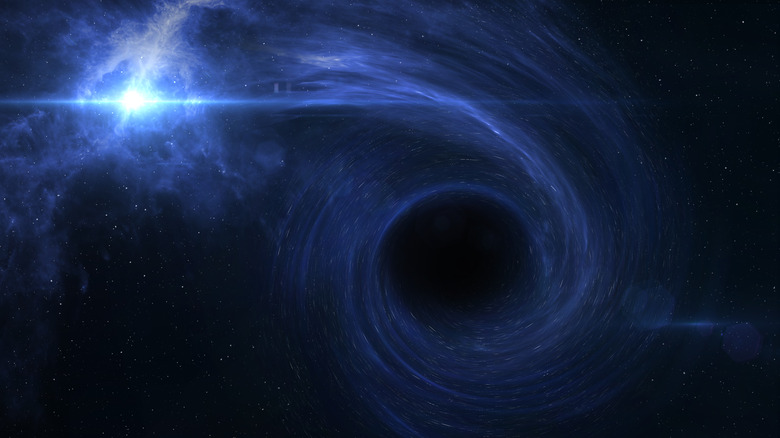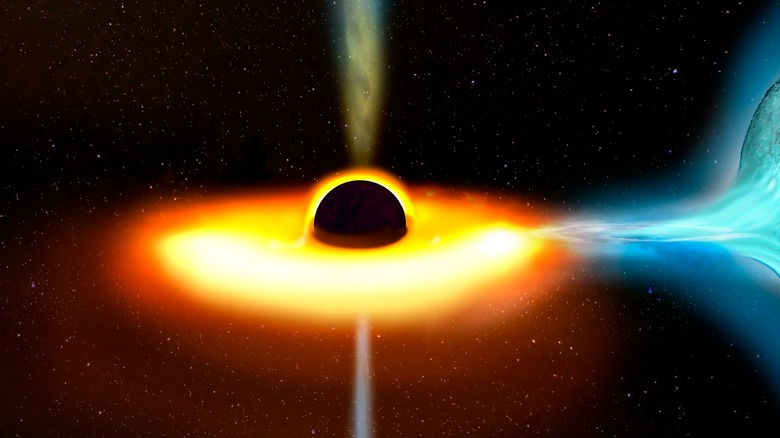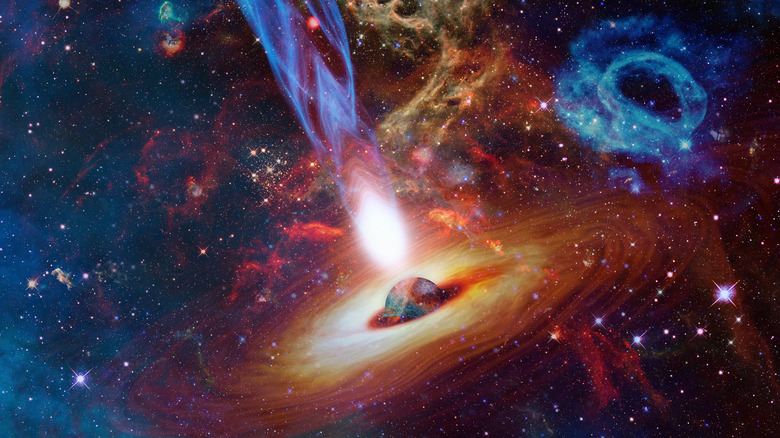Researchers Are Stumped At The Staggering Amount And Speed Of The Energy Emitted By A Black Hole
We all know about black hole basics at this point, right? Lots of folks envision them as giant space mouths devouring anything that gets too close, and that's a decent analogy. If a star is small enough when it uses up its fuel, it'll blast apart into a supernova. If it's massive enough, its gravity will compress the whole thing into an infinitely dense spot. The latter scenario creates smaller, stellar black holes, as Space explains. In the center of each galaxy rests a supermassive black hole, like Sagittarius A in the middle of our own Milky Way. Researchers took a picture of it for the first time on May, 2022, as Quanta Magazine describes. Like the planets of our solar system to the sun, our entire galaxy revolves around it.
And what happens when an object gets too close to a black hole? Well, black holes spin like a top, the same as Earth, the sun, and so on. Except black holes actually rotate at nearly the speed of light, as Big Think says. You might be inclined to imagine a whirlpool that sucks objects in, but a hurricane is a better comparison. There's some outer edge — the event horizon. If things get too close they get snagged. And if the thing, in this case, is a gas star, it'll get "spaghettified" — pulled off in gassy strands. But now, for some reason, a black hole 665 million light years away is spitting bits of a star back out, per Space.
A planet unraveling like spaghetti
To be clear, the black hole in question is not sucking bits of a planet all the way in, and then jettisoning them out — that's impossible. Once an object is caught in the event horizon, it's gone for good. Space explains that if an object gets close to the event horizon — the point of no return — the gravity gets strong enough to compress or squish an entire planet. Here on Earth, we experience a similar effect every day: tides. In our case, as NASA outlines, tides are caused by our moon. Earth is a rocky planet, so it can't squish. But its waters — a material much more flexible than stone — can bulge. The Earth rotates through its watery bulge every 24-hour day, and this is what we experience as the tide.
So what if a whole planet is made of water or gas? Well, when it gets close enough to a body of strong gravity, like a black hole, a "tidal disruption event" happens (TDE). One side of the planet gets stretched out like bubble gum, and the other side gets squashed. And because the black hole is spinning, the planet looks like it's unspooling. Researchers rather ingloriously call this "spaghettification," although you can imagine a dropped toilet paper roll leaving a paper trail behind as it rolls away, if you'd like. TDE AT2018hyz, however, seems to be leaving behind an unusually large paper trail, as NPR describes.
Way, way hotter and faster than expected
TDE AT2018hyz was first observed back in 2018. For the first three years of observation, the star getting pulled into the black hole didn't really do much of anything, as Space says. But all of a sudden it lit up and became "one of the most radio-luminous TDEs ever observed," researcher Edo Berger said. The event came as a complete surprise to lead researcher Yvette Cendes, astronomer at the Harvard & Smithsonian Center for Astrophysics, who headed up the current study.
When Berger and others say that the TDE "lit up," they're referring to the flash of light that happens during spaghettification. Typically, shredded star material belched out by a TDE travels at about 10% of the speed of light. In TDE AT2018hyz's case, the material is moving at almost half the speed of light. There's also a greater amount of material — the outflow — than expected. On NPR, Cendes says that a high-energy outflow only happens about 1% of the time. This makes this an "extremely jetted event."
Researchers used a variety of global telescopes to monitor TDE AT2018hyz, which could rewrite some of our understanding of how black holes and TDEs operate. Starting with the Very Large Array (VLA) in New Mexico, the MeerKAT radio telescope in South Africa jumped on board, as well as the Atacama Large Millimeter/submillimeter Array in Chile, and more. At present, astronomers are still gathering data and trying to figure the whole thing out.


